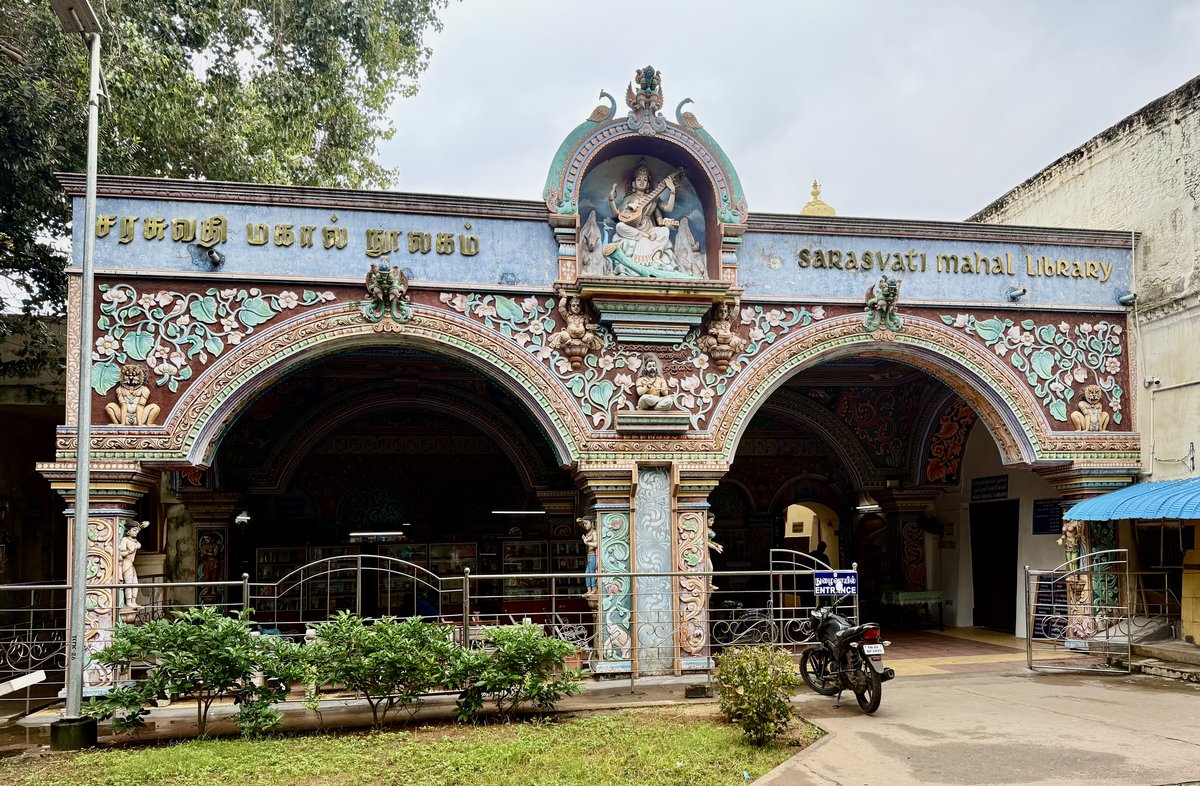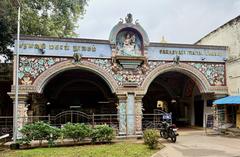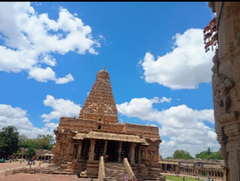
Saraswathi Mahal Library Visiting Hours, Tickets, and Historical Significance in Thanjavur
Date: 14/06/2025
Introduction
The Saraswathi Mahal Library, located within the Thanjavur Palace complex in Tamil Nadu, is one of Asia’s oldest and most celebrated libraries. Established in the 16th century during the reign of the Nayak dynasty and significantly expanded under the Maratha ruler Maharaja Serfoji II, the library today stands as a testament to South India’s long tradition of scholarship, art, and cultural preservation. With a collection that spans over 60,000 volumes, including rare palm-leaf manuscripts, ancient maps, and texts in multiple languages, the Saraswathi Mahal Library is a beacon for researchers, history enthusiasts, and travelers alike.
This guide provides detailed information about the library’s historical development, collection highlights, visiting hours, ticketing policies, accessibility, and practical tips for visitors. It also explores ongoing conservation and digitisation efforts, ensuring that this unique repository continues to inspire future generations.
For further exploration and the latest updates, refer to official resources and digital initiatives (Tamil Nadu Public Libraries, Tamil Nadu Tourism, Serfoji Memorial Hall).
Table of Contents
- Historical Overview
- Collections and Manuscript Highlights
- Conservation and Digitisation Efforts
- Visiting Information
- Frequently Asked Questions (FAQs)
- Conclusion and Visitor Recommendations
- References and Further Reading
Historical Overview
Origins and Early Development
Founded in 1535 CE by the Nayak rulers of Thanjavur, the Saraswathi Mahal Library was initially part of the palace’s private collection, supporting scholars and poets with manuscripts primarily in Sanskrit and Tamil. The Nayaks’ patronage laid the groundwork for the library’s initial growth, focusing on Vedic texts, Agamas, classical literature, and traditional sciences.
Expansion Under the Marathas
The Maratha conquest of Thanjavur in the late 17th century ushered in a golden era for the library. Under rulers like Venkoji and especially Maharaja Serfoji II, the library’s holdings expanded to include manuscripts in Marathi, Telugu, and English, broadening its scope to cover a wide range of disciplines: astronomy, mathematics, medicine, music, and more.
Maharaja Serfoji II’s Contributions
A visionary ruler and polymath, Maharaja Serfoji II (1798–1832) revolutionized the library by acquiring rare manuscripts from across India and abroad, introducing systematic cataloguing, and supporting multidisciplinary collections. His efforts ensured the preservation and expansion of the library’s resources, making it a repository of both Eastern and Western knowledge.
Collections and Manuscript Highlights
Palm-Leaf Manuscripts
The Saraswathi Mahal Library is renowned worldwide for its palm-leaf manuscript collection, which includes over 49,000 items. These manuscripts span languages such as Tamil, Sanskrit, Telugu, Marathi, and Malayalam, and cover subjects like Vedic literature, philosophy, music, medicine, botany, and fine arts (The Hindu, Serfoji Memorial Hall, Shanlax Journals).
Paper Manuscripts and Printed Books
In addition to palm-leaf manuscripts, the library boasts a significant collection of paper manuscripts and printed books—over 75,000 titles in total. Highlights include rare books from Raja Serfoji II’s personal library, as well as multilingual catalogues meticulously compiled since the early 19th century (New Indian Express).
Artistic and Visual Treasures
The library’s holdings extend beyond texts to include:
- Thanjavur-style paintings on wood, canvas, and glass
- Illustrated folios on subjects such as Gaja Sastra, Aswa Sastra, and Chitra Ramayana
- Miniature manuscripts with micrographic calligraphy, such as the Shivaprapancharatna Stotram
- Atlases, anatomical plates, and portraits of Maratha kings
A dedicated museum section showcases select artifacts for public viewing (Serfoji Memorial Hall).
Conservation and Digitisation Efforts
Traditional Conservation
Manuscript preservation at Saraswathi Mahal Library employs traditional methods, such as cleaning and treating palm leaves with citronella oil to prevent fungal and insect damage. Seasoning processes ensure the longevity of these fragile documents (Academia.edu).
Modernisation and Digitisation
Digitisation projects, launched in 2015, aim to preserve and provide wider access to the collection. High-resolution scanning and computerised cataloguing have made significant strides, though access to digital holdings remains limited (The Hindu).
Current Challenges
Despite ongoing efforts, the library faces challenges, particularly staff shortages that have led to the suspension of routine conservation activities. Only 14 out of 46 positions are currently filled, impacting cleaning, cataloguing, and maintenance work (New Indian Express). Sustained advocacy and increased funding are critical for the library’s future.
Visiting Information
Hours and Tickets
- Open: Tuesday to Sunday
- Timings: 9:00 AM to 5:00 PM (some sources note 10:00 AM to 5:00 PM; confirm with the official site before visiting)
- Closed: Mondays and public holidays
- Entry: Free for all visitors. Researchers require prior permission to access rare or sensitive materials (tamilnadupubliclibraries.org).
Location and Accessibility
The library is central to the Thanjavur Palace complex, about 2 km from Thanjavur Junction railway station and 0.5 km from the old bus stand. The nearest airport is Tiruchirappalli International Airport, roughly 48 km away (tamilnadutourisminfo.com). The premises offer ramps for wheelchair users, but some heritage sections have limited mobility access.
Visitor Tips and Nearby Attractions
- Best visiting months: October to March for comfortable weather
- Dress code: Modest clothing is recommended
- Footwear: Comfortable walking shoes suggested for uneven surfaces
- Photography: Strictly prohibited inside the library
- Guided Tours: Local guides are available for hire at the palace complex, though not within the library itself
- Nearby sites: Brihadeeswarar Temple (UNESCO World Heritage Site), Thanjavur Royal Palace, Art Gallery
Frequently Asked Questions (FAQs)
Q: Is there an entry fee?
A: No, entry is free for all visitors.
Q: Are photography and videography allowed?
A: No, these are strictly prohibited inside the library.
Q: How accessible is the library for individuals with disabilities?
A: There is moderate accessibility; some areas may be challenging due to historic architecture.
Q: Can researchers access the full manuscript collection?
A: Researchers need to obtain prior permission from library authorities for special access.
Q: Are guided tours available?
A: While there are no official guides inside the library, local guides can be hired for the palace complex.
Conclusion and Visitor Recommendations
The Saraswathi Mahal Library remains a living monument to India’s intellectual and cultural legacy. From its origins under the Nayak rulers through its golden age with Maharaja Serfoji II, the library continues to inspire as a hub for research, preservation, and cultural engagement. Despite ongoing challenges, particularly with staffing, the commitment to digitisation and conservation ensures the continued relevance and accessibility of its treasures.
Whether you are a scholar or a traveler, planning your visit with knowledge of the library’s hours, visitor guidelines, and nearby attractions will enrich your experience. For updates, official information, and digital resources, refer to the links below.
References and Further Reading
- Saraswathi Mahal Library in Thanjavur: History, Visiting Hours, Tickets & Visitor Guide, 2025 (Tamil Nadu Public Libraries)
- Saraswathi Mahal Library in Thanjavur: Visiting Hours, Tickets, and Cultural Heritage, 2025 (Tamil Nadu Tourism)
- Visiting the Saraswathi Mahal Library in Thanjavur: Hours, Tickets, Collections, and Historical Insights, 2025 (Serfoji Memorial Hall)
- Digitisation of palm leaf manuscripts begins, The Hindu, 2015 (The Hindu)
- Staff shortage historic library in Thanjavur languishes from neglect, New Indian Express, 2024 (New Indian Express)
- Palm Leaf Manuscript Conservation: The Process of Seasoning (Academia.edu)
- Shanlax Journals
- Wikipedia


